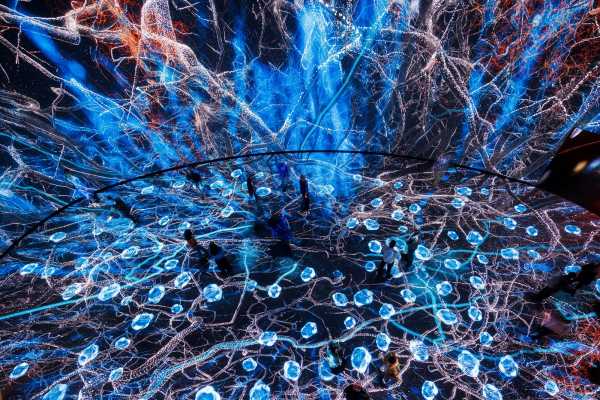
It is not uncommon to hear the director of a fine-art museum, presiding over the ribbon-cutting for a shiny new wing, declare that its architecture is so pathbreaking that the building itself, far from being a mere container, deserves to be thought of as part of the permanent collection. The architect Jeanne Gang, the lead designer of the new Richard Gilder Center for Science, Education, and Innovation at the American Museum of Natural History, in Manhattan, has given her clients every opportunity to make a similar claim. Here, though, the affinity to the collection flows not from an avant-garde approach, but, as seems fitting for a natural-history museum, a timeworn and elemental one. This new wing is anything but shiny.
The centerpiece of the Gilder Center, which will open to the public on May 4th, is a dramatic cavelike atrium, lined in sand-colored, rough-edged concrete, that soars, dips, and bends through five levels and eighty-three feet of vertical space—a kind of slot canyon for the Upper West Side. The Times, in a pair of articles published when the design was unveiled, in 2015, compared it to Jurassic Park and Dr. Seuss and said that it “evokes the Flintstones’ town, Bedrock.” Beyond Hanna-Barbera, the relevant architectural precedents include Erich Mendelsohn’s Einstein Tower in Potsdam, Germany, of 1921; thin-shell mid-century designs by Félix Candela and Eero Saarinen, as well as Saarinen’s Morse and Ezra Stiles residential colleges at Yale; Le Corbusier’s curvilinear but substantial late-career buildings, in particular his concrete Notre Dame du Haut chapel on a hilltop in Ronchamp, France, completed in 1955; the 2014 Serpentine Pavilion in London’s Kensington Gardens by Chile’s Smiljan Radić, a temporary structure that resembled an oversized dinosaur egg; and the undulating ceiling in the lobby of the 2015 Broad museum, in Los Angeles, by the New York firm Diller Scofidio + Renfro.
If there are any hints in the atrium of the software-powered approach known as parametric design—often the source in recent years of buildings with seemingly turbocharged fluidity—they are slipped beneath an architectural filter set to Stone Age. In fact, the method used to create this moonscape of a room, officially the Kenneth C. Griffin Exploration Atrium, has workmanlike roots, in the construction of swimming pools and subway tunnels. The walls of the atrium, which looks out over Theodore Roosevelt Park and Seventy-ninth Street, are produced using a method called shotcrete, in which concrete is sprayed directly onto rebar and metal mesh, without the need for formwork, and finished by hand before it cures. (Depending on the context, the word shotcrete can refer either to the technique or to the material that the technique produces.) Sometimes trowels are used for the final step; at the Gilder Center, the construction crew used long rods, resembling squeegees, and guide wires attached to the rebar. This allowed them to create not only a rocklike, fossilized texture and complex curves but also the sharp creases found in the canyons that Gang and her colleagues toured in the American Southwest.
According to the American Concrete Institute (motto: “Always advancing”), “Although the hardened properties of shotcrete are similar to those of conventional cast-in-place concrete, the nature of the placement process results in an excellent bond with most substrates, and rapid or instant capabilities, particularly on complex forms or shapes.”
“You can sandblast it smooth,” Weston Walker, a design principal and partner for Studio Gang, the firm that Jeanne Gang founded in Chicago, told me about the shotcrete surface as we stood in the atrium one afternoon last week. “You could even get it to smoothness of precast concrete if you wanted. But”—and this last part seemed superfluous, given what surrounded us—“we didn’t.”
As Gang, Walker, and other colleagues were preparing the design of the new wing, they descended far below Manhattan to observe the construction of the East Side Access project, the M.T.A.’s giant effort to connect the Long Island Rail Road to a new station beneath Grand Central Terminal. There they watched crews spray shotcrete onto rebar on the ceiling, creating a series of vaulted, cathedral-like spaces. There are also connections to shotcrete in the museum’s own history. Carl Akeley, a taxidermist, big-game hunter, writer, and inventor—the history of any natural-history museum is also a history of polymathy—who worked at A.M.N.H. from 1909 to 1926, was the first to figure out how to spray plaster through a nozzle, using a compressed-air technique, which eventually gave rise to shotcrete. Gang told me she wasn’t aware of the Akeley connection when she first considered using this method on the project.
The two-hundred-and-thirty-thousand-square-foot Gilder Center is a microcosm, or, if you prefer, a fractal, of the museum as a whole, in the sense that it holds essentially every kind of space you can find elsewhere in the sprawling A.M.N.H. complex. (Three older structures were removed to make room for it.) The wing contains a half-dozen exhibition spaces (including a “collections core” along its southern edge that opens research and storage spaces to view behind floor-to-ceiling glass), eighteen new and renovated classrooms, two shops, a ticketing and visitor-services area, a stunning and high-ceilinged library, and, beneath a honeycomb light fixture, the museum’s only table-service restaurant, the Restaurant at Gilder, which has beer and wine on tap. It also features the “Invisible Worlds” immersive experience, presented in an oval-shaped venue with a mirrored ceiling, where the story of the planet and its organisms is narrated on a twelve-minute loop. This room is impressive enough in the quality of its digital imagery to make you wonder how long architecture, so slow-footed and earthbound by comparison, can compete with technology for the attention of visitors.
At least Gang is willing to try. Indeed, the drama of the atrium, its very scale and geological sweep, gave the architect a way to address one of the most ambitious goals for the project as articulated by Ellen V. Futter, who presided over the museum for three decades until stepping down last month. (Her successor is Sean M. Decatur, the former president of Kenyon College.) Futter, from the start, hoped to use the Gilder Center to counter growing evidence of what she called the “denial of science.” The need for that campaign only seems to have intensified after Donald Trump won the Presidency. In a 2017 news conference announcing updates to Gang’s design, Futter said: “In a post-truth world, understanding science has never been more urgent.”
This raises the question, of course, of what specific role architecture can play in bolstering or backstopping science, or in creating a new museum wing robust enough to meet our fraught political, ecological, and cultural moment. Gang—whose firm collaborated on the project with the exhibition designer Ralph Appelbaum Associates, the landscape architecture firm Reed Hilderbrand, and, as executive architect, with Davis Brody Bond—imagined that one way might be to install charismatic, cutting-edge exhibits within an architectural envelope that is itself a spectacle. The goal was to demonstrate that nature is awe-inspiring, yes—but also that the quest to understand and document it might bring us closer to the wellspring of that awe.
The only other museum I know of that uses shotcrete in its public spaces is the 2010 Holocaust Museum L.A., formerly the Los Angeles Museum of the Holocaust, by the architect Hagy Belzberg. In that project, the match between material and mission—between the fluid, changeable, and expedient character of the shotcrete and the goals of the museum, to fix in memory among the darkest of human histories—is jarring. The fit is far better in Gang’s design. The rough openings in the atrium’s sidewalls resemble portholes but also cave entrances, the insides of blood vessels, and the eyes and mouths of otherwise unseen creatures. Thanks to a number of large skylights, the play of light and shadow across the space is exquisite. Sure, the shotcrete—a tricky and unpredictable material to wrangle—looks patchy in a small handful of locations. Yet, in an age when every expanding cultural institution seems to be adding a new building made of glass and steel, or, increasingly, with giant, exposed mass-timber beams, a sculptural atrium marked by a kind of lunar strangeness is a welcome change.
For Gang and her colleagues, this effort to fend off “post-truth” attacks on science was just the first part of what turned out, in architecture and urban-design terms, to be a three-front war. The second and in certain ways most complex front was in Theodore Roosevelt Park (né Manhattan Square) outside, where some neighbors worried that the new wing would impose too dramatically on this relatively small but leafy and intensely well-used stretch of green space along what has long felt like the back side of the museum, along Columbus Avenue. One of the neighborhood groups, Landmark West!, included an ominous-sounding quote from Roosevelt, rather wrenched out of context, on its Web site: “No man is justified in doing evil on the ground of expediency.”
Fairly quickly after these complaints emerged, the museum agreed to pull back the new wing so that it is nearly flush with the A.M.N.H. buildings on either side: the old 1931 Power House to the north and, to the south, Charles Volz’s elegant Romanesque Revival wing, from 1908. It also makes a point of matching the cornice line of those buildings. Clad on its exterior with panels of Milford pink granite, in homage to the museum’s eastern façades along Central Park West, the Gilder Center manages to step gracefully—if carefully!—into Theodore Roosevelt Park. In the end, its footprint, according to the museum, takes up just a quarter of an acre more park space than was the case before construction.
I don’t want to oversell the rationality of the new wing’s exterior—it has its own bulges and kinks, along with sculpturally rounded windows, with fritted, bird-safe glass, in a range of sizes—but, compared with the atrium behind it, what stands out is its aplomb. The Reed Hilderbrand design, though it was still unfinished when I visited last week, appears to have given Theodore Roosevelt Park an upgrade, especially in terms of seating and the smoothness of the paths where kids from the neighborhood learn how to ride bicycles.
The site, despite its many constraints, also gave Gang the opportunity to add a new entrance on axis with the Central Park West front door and with Seventy-ninth Street, as at least one version of the museum’s master plan intended—and to provide a view from the atrium, on at least two evenings per year, of the phenomenon known as Manhattanhenge, when the setting sun lines up precisely with the Manhattan street grid, just as Stonehenge is arranged to frame solstice views. (The term was popularized by Neil deGrasse Tyson, the director of the museum’s Hayden Planetarium.) “There aren’t many chances to do a building en axe in New York,” Gang said.
The final challenge for Studio Gang was an interior one: how to use the new wing to untangle some of the knots that had developed in the museum over time, bringing clarity of views and circulation patterns to what had become an unruly collection of twenty-five intertwined buildings, their corridors typically packed with tourists, school groups, and stroller traffic. “A major remit was to resolve dead ends,” Walker said. The new wing alone features thirty-three connections to ten different A.M.N.H. buildings.
In this effort, the Gilder Center is less successful. At the top of the main stair, a wide space that doubles as seating, visitors are met with a giant wall of white acoustic plaster, blank except for some subtle vertical and horizontal scoring—an architectural element so out of place that I asked one of my A.M.N.H. guides through the new building, Anne Canty, if it was temporary or signalled ongoing construction. Neither, she said. Gang’s office told me in an e-mail that the area is “planned as space for a future exhibit, but the content for it is still being developed.” A similar wall treatment reappears in other parts of the Gilder Center, including next to the restaurant’s big picture windows.
A second, less prominent stair on the south side of the new wing, with railings of black-painted steel, connects the second through fourth floors; graceful in silhouette, it seems overscaled for its spot. In one location, on the second-floor landing, there is an uncomfortably pinched space between the stair and one of the portal-like openings in the atrium that are sure to be a draw for New Yorkers and tourists alike looking for Instagrammable moments, of which the new wing provides a nearly bottomless supply. (In adding new galleries, museum leaders used to chase square footage, sometimes more than was altogether sensible, and celebrity architects; they still do both, but these days they undeniably covet social-media-ready spaces as well. They certainly noticed when the Broad’s honeycomb exterior, in the days after its début, became a fixture on Instagram, helping the museum build an enviably large, young, and diverse visitor base.)
These circulation issues are not quite as baffling as those that plague Renzo Piano’s 2015 Whitney Museum downtown, where a prominent central stair ends shy of the top exhibition floors, leaving museumgoers to search for a fire stair to take them the rest of the way. But, for repeat visitors, especially those who pay close attention to architecture, these shortcomings may grate over time. On the whole, Gang’s design is strong as poetry and—where it meets the park and the neighbors—a kind of delicate architectural version of legalese. As prose, not so much.

The immersive experience “Invisible Worlds.”
How much should that matter, in the end? It certainly won’t for the thousands upon thousands of schoolkids who will visit each year and gape at the atrium, thrill to the digital pyrotechnics of “Invisible Worlds,” and flock to the insectarium and the utterly charming butterfly vivarium. It likely won’t for most of the researchers who use the library on the fourth floor, which includes a small gallery space behind a wall of bookshelves and is dominated by a single treelike column.
Especially on the pedestrian bridges that span the atrium on the third and fourth levels, visitors will likely be tempted to belly up, as I was, to the chunky shotcrete parapets, topped with deep, angled shotcrete rails, and take in the architecture of the new wing. Standing there, they may find it hard to resist touching the surface—and discover that it is brittle enough to crumble right in their hands. (The building itself may need to be swept up after, and I wonder how it will age.) I was careful to avoid this outcome when I touched the material, gingerly, for the first time; nonetheless, a small piece of shotcrete, no bigger than a dime, wound up in my palm. I slipped it into my shirt pocket, as a souvenir. ♦
Sourse: newyorker.com






